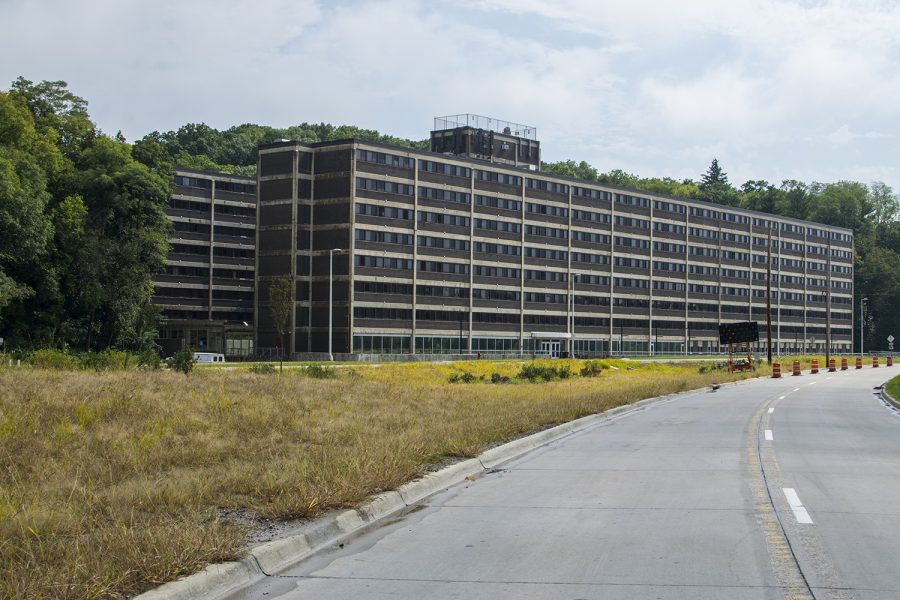Mayflower operates at 60% capacity to give returners on-campus living space
UI Housing and Dining has converted some of the double rooms in Mayflower into singles to give returning students the opportunity to continue to live on campus.
Mayflower residence hall is seen on Wednesday, Sept. 19, 2018. Mayflower is currently functioning at 60 percent capacity to allow for more single rooms.
September 24, 2018
The University of Iowa’s Mayflower Hall is operating at a lower capacity in order to make room for returning students to live on campus.
The residence hall is operating at 60 percent capacity. University Housing & Dining can adjust the capacity of a building each year based on the UI enrollment.
This year, Housing & Dining converted some of the double rooms in Mayflower to single rooms to give returning students the option of living on campus but having more independence than in a traditional dorm room, said Assistant Vice President Von Stange, the senior director of Housing & Dining.
There remains a mix of double and single rooms in Mayflower. The number can change in the future depending on the interest in single rooms as well as an increase or a decrease in the number of first-year students, Stange said.
The UI has made an effort to manage enrollment, making such a change possible. According to a February report to the state Board of Regents, the enrollment headcount during fiscal 2018 was 33,564. The enrollment forecast for fiscal 2023 is 33,500.
The UI projected the ratio of the residence system’s capacity to its occupancy to decline starting in fiscal 2019, the current budget year, from 95.2 percent in fiscal 2018 to 88.9 percent in the current fiscal year through fiscal 2023.
RELATED: University of Iowa enrollment down after intentional growth management
Virginia Ibrahim-Olin, the assistant director of contracts and assignments in Housing & Dining, said officials thought Mayflower would be a good residence hall to use to meet the rising demand from returning students for single rooms.
Housing & Dining sees Mayflower as more of a transitional living facility, because two rooms share a small kitchenette and bathroom.
While Stange said no plans are in place for the future of Mayflower, the vision for the residence hall likely would involve more community spaces on floors and allowing students easier access from one side of each floor to the other.
“With [the] opening of Catlett in the past year, the university can comfortably support first-year students and returning students in ways we’ve always wanted to, and we would enjoy having second-year students, third-, and fourth-year students live with us,” Ibrahim-Olin said.
RELATED: UI considers on-campus living requirement for sophomores
In the past, Mayflower rooms have been more expensive because of the inclusion of the kitchenette and shared bathroom. Now, a single room in Mayflower costs the same as a single room in Currier, she said.
Third-year student Daniel Folchert, a Mayflower resident, said the living situation is more spacious and less busy compared with the other dorms. He has also been able to keep his car in the back parking lot, he said, which makes commuting to and from the rest of campus easier.
Being able to cook and have a hot meal at any time has been nice perk of living in Mayflower, he said, because it’s cheaper to cook for oneself than to pay for a meal plan.
“It works better for me financially to be able to take out a loan for living rather than pay month to month now,” Folchert said.
Stange said they made more single rooms specifically in Mayflower to create more space for returning students who still wanted to live on campus and pay for room and board with financial aid, while allowing them to have more privacy and space.
Housing & Dining officials know that some students may want to have their own room, Stange said, and they found a way through Mayflower for students to have that opportunity while still living on campus.
Housing & Dining has taken other steps to encourage students to live on campus through opening up the housing application earlier, giving tours of all the residence halls, and, in Mayflower, allowing returning students to request to live on a floor together.
The UI has also created a “Second-Year Experience” task force dedicated to finding the best ways to make second-year students more successful. One of its initiatives is a voluntary pilot program to explore an on-campus living requirement for freshmen and sophomores, set to begin next year.






